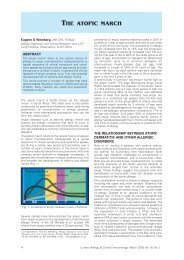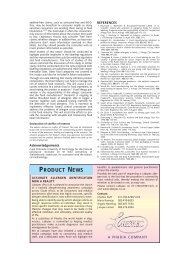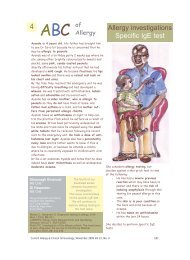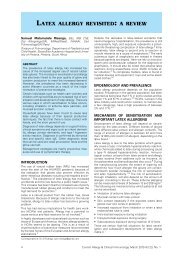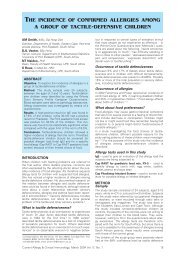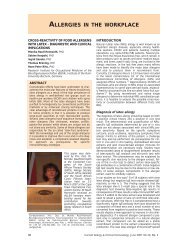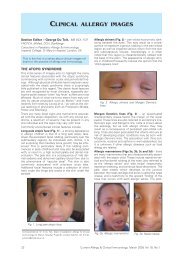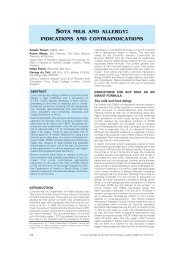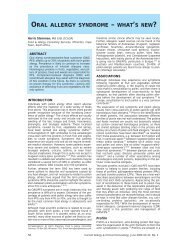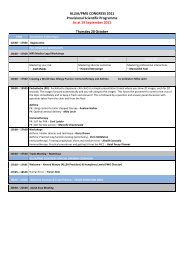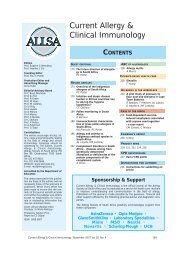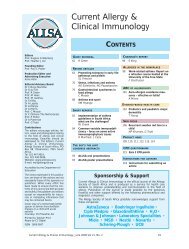SNIPPETS FROM THE JOURNALSAllan S Puterman, MB ChB, FCP, FAAAAIThe November 2007 edition of the Journal of <strong>Allergy</strong><strong>and</strong> <strong>Clinical</strong> <strong>Immunology</strong> contains the long-awaitedreport of the National Asthma Education <strong>and</strong>Prevention Program – Expert Panel Report 3.This report entitled Guidelines for the Diagnosis <strong>and</strong>Management of Asthma is also supported by the USADepartment of Health <strong>and</strong> Human Science NationalInstitutes of Health <strong>and</strong> the National Heart, Lung <strong>and</strong>Blood Institute.This is one of the most comprehensive guidelines onasthma management currently published. The guidelinesopen with a detailed disclosure of financial interestsby all participants. The guidelines define asthma,explore the diagnosis <strong>and</strong> exp<strong>and</strong> on long-term management.Management consists of four components including:• assessing <strong>and</strong> monitoring asthma severity <strong>and</strong> control• education for a partnership of care• control of environment <strong>and</strong> comorbid conditions• medication.The panel emphasises the importance of control buttakes into account both the degree that manifestationsof asthma are minimised by therapeutic intervention(control) as well as the intrinsic intensity (severity) ofthe disease process in a particular patient. The panelrecommends that for managing asthma, one should‘assess severity to initiate therapy <strong>and</strong> assess controlto adjust therapy’.New concepts introduced include ‘<strong>Current</strong> impairment’which refers to frequency <strong>and</strong> intensity of symptoms,low lung function <strong>and</strong> limitations of daily function.Further ‘Future risk’ refers to a likelihood of exacerbations,progressive loss of lung function <strong>and</strong> adverseeffects of medication. The guidelines stress that somepatients may be at high risk for exacerbations eventhough they have few day-to-day symptoms.The educational aspect confirms the importance ofteaching patients skills to self-monitor <strong>and</strong> manageasthma. A written asthma action plan is key. New recommendationsencourage exp<strong>and</strong>ing education intoschools <strong>and</strong> also deal with clinician education.The stepwise approach is emphasised with theincrease to 6 steps from the original 4. I have taken theliberty of reproducing Figure 13 ‘Stepwise approach formanaging asthma long-term in children 0 to 4 <strong>and</strong> 5 to11’, firstly, to show how this guideline is both comprehensiveyet simple, <strong>and</strong> secondly because it covers theage group that is often the most problematic.This guideline supplement is a timely addition as it mayprovide the answer to a pertinent question asked byHans Bisgaard in the Letters to the Editor section ofthe JACI October 2007 edition, namely ‘What drivesprescription patterns in pediatric asthma management?’He has analysed data from the Danish Asthma Registerof Medicinal Products Statistics which containsrecords from all prescriptions for medicinal productsprescribed in Denmark. His analysis shows anincreased prescription in children of combinationICS/LABA products as well as an increased use ofthese products as first-line treatment in previouslysteroid-naïve children. Both trends are contrary toDanish guidelines. His discussion includes possiblereasons, such as real-life experience may be betterthan clinical trials, <strong>and</strong> disease severity may be increasing.Pharmacuetical industry pressure <strong>and</strong> inefficientguideline dissemination are also mentioned.The answer to Bisgaard’s question may lie in a verysimple line that is repeated often in the new Americanguidelines. ‘The stepwise approach is meant toassist, not replace, the clinical decision-makingrequired to meet individual patient needs.’Correspondence: Dr A Puterman, e-mail: putall@global.co.za44 <strong>Current</strong> <strong>Allergy</strong> & <strong>Clinical</strong> <strong>Immunology</strong>, <strong>March</strong> <strong>2008</strong> Vol 21, No. 1
➞Step up if needed (first check inhaler technique, adherence, environmental control, <strong>and</strong>comorbid conditions)Assist controlStep down if possible (<strong>and</strong> asthma is well controlled at least 3 months)Step 6➞Step 5Step 4Step 3Step 2Step 1NotesChildren 0-4 Years of AgePreferredAlternativeQuick-ReliefMedicationIntermittentAsthmaPersistent Asthma: Daily MedicationConsult with asthma specialist if step 3 care or higher is required. Consider consultation at step 2.SABA PRN Low-dose ICS Medium-dose ICS Medium-dose ICS+LABA ormontelukastCromolyn ormontelukastEach Step: Patient Education <strong>and</strong> Environment ControlHigh-dose ICS+LABA ormontelukastHigh-dose ICS+LABA ormontelukast• SABA as needed for symptoms: Intensity of treatment depends on severity of symptems• With viral respiratory symptoms: SABA q 4-6 hours (longer with physician consult).Consider short course of oral systemic corticosteroids if exacerbation is severe or patient hashistory of previous sever exacerbations.Caution: Frequent use of SABA may indicate the need to step up treatment. See text* forrecommendations on initiating daily long-term-control therapy.+oral corticosteroids• The stepwise approach is meant to assist, not replace, theclinical decision-making required to meet individual patientneeds.• If an alternative treatment is used <strong>and</strong> response isinadequate, discontinue it <strong>and</strong> use the preferred treatmentbefore stepping up.• If clear benefit is not observed within 4-6 weeks, <strong>and</strong>patient’s/family’s medication technique <strong>and</strong> adherence aresatisfactory, consider adjusting therapy or an alternativediagnosis.• Studies on children 0-4 years of age are limited. Step 2preferred therapy is based on Evidence A.* All otherrecommendations are based on expert opinion <strong>and</strong>extrapolation from studies in older children.• Clinicians who administer immunotherapy should beprepared <strong>and</strong> equipped to identify <strong>and</strong> treat anaphylaxis thatmay occur.Key: Alphabetical listing is used when more than one treatmentoption is listed within either preferred or alternative therapy.ICS, inhaled corticosteroid; LABA, inhaled long-actingß 2 -agonist; LTRA, leukotriene receptor antagonist; oral corticosteroids,oral systemic corticosteroids ; SABA, inhaled shortactingß 2 -agonist.Children 5-11 Years of AgePreferredAlternativeQuick-ReliefMedicationIntermittentAsthmaPersistent Asthma: Daily MedicationConsult with asthma specialist if step 4 care or higher is required. Consider consultation at step 3.SABA PRN Low-dose ICS Low-dose ICS+Cromolyn,LTRA,nedocromil ortheophylineLABA , LTRA ortheophylineORMedium-dose ICSMedium-dose ICS High-dose ICS++LABALABAMedium-dose ICS+LTRA ortheophylineHigh-dose ICS+LTRA ortheophylineHigh-dose ICS+LABA+oral corticosteroidsHigh-dose ICS+LTRA ortheophyline+oral corticosteroidsEach Step: Patient Education, Environment Control, <strong>and</strong> Management ofComorbiditiesSteps 2-4: Consider subcutaneous allergen immunotherapy for patitentswho have persistent, allergic asthma• SABA as needed for symptoms: Intensity of treatment depends on severity of symptoms up to3 treatments at 20-minute intervals as needed. Short course of oral systemic corticosteroidsmay be needed.Caution: Increasing use of SABA or use >2 days a week for symptom relief (not prevention of EIB)generally indicates inadequate control <strong>and</strong> the need to step up treatment.• The stepwise approach is meant to assist, not replace, theclinical decision-making required to meet individual patientneeds.• If an alternative treatment is used <strong>and</strong> response isinadequate, discontinue it <strong>and</strong> use the preferred treatmentbefore stepping up.• Theophyline is a less desirable alternative due to the needto monitor serum concentration levels.• Step 1 <strong>and</strong> step 2 medications are based on Evidence A.*Step 3 ICS <strong>and</strong> ICS plus adjunctive therapy are based onEvidence B* for efficacy of each treatment <strong>and</strong> extrapolationfrom comparator trials in older children <strong>and</strong> adults –comparator trials are not available for this age group; steps4-6 are based on expert opinion <strong>and</strong> extrapolation fromstudies in older children <strong>and</strong> adults.• Immunotherapy for steps 2-4 is based on Evidence B* forhouse-dust mites, animal d<strong>and</strong>ers, <strong>and</strong> pollens; evidence isweak or lacking for moulds <strong>and</strong> coclroaches. Evidence isstrongest for immunotherapy with single allergens. The roleof allergy in asthma is greater in children than adults.• Clinicians who administer immunotherapy should beprepared <strong>and</strong> equipped to identify <strong>and</strong> treat anaphylaxis thatmay occur.Key: Alphabetical listing is used when more than one treatmentoption is listed within either preferred or alternative therapy.EIB, exercise-induced bronchospasm; ICS, inhaled corticosteroid;LABA, inhaled long-acting ß 2 -agonist; LTRA, leukotrienereceptor antagonist; SABA, inhaled short-acting ß 2 -agonist.*See original article for details<strong>Current</strong> <strong>Allergy</strong> & <strong>Clinical</strong> <strong>Immunology</strong>, <strong>March</strong> <strong>2008</strong> Vol 21, No. 1 45



